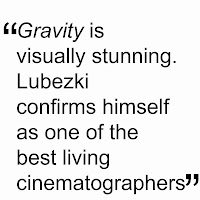Gravity is the latest feature by Alfonso Cuarón (Children of Men, Harry Potter and the Prisoner of Azkaban, Y tu Mamá También), a sci-fi film that takes us into the space with Sandra bullock and George Clooney.
The plot. While outside the shuttle, on a spacewalk repairing a satellite, disaster hits the medical engineer Sandra Bullock and the veteran astronaut George Clooney; the shuttle is destroyed and they have to find a way to get back to earth.
Camera: Arri Alexa
Lenses: Zeiss Master Prime
Aspect ratio: 2.35:1
Format: ARRIRAW
Film Stock: -
Emmanuel Lubezki (Children of Men, The Tree of Life, To the Wonder, Ali) proves himself, once again, to be one of the finest working cinematographer, and this time choosing digital (instead of the usual film stock) and showing us that he can master digital light too. Even if there's lots of CGI (almost everything you see on screen is fake), the cinematography of Gravity is absolutely stunning.
The approach to lighting Lubezki makes is, as he always uses to do, very natural: being in space, he uses the sun as main light source and very often as Key Light, both for the spacewalks scenes and the scenes shot inside the shuttle; but he also uses stars and the earth as light sources, the latter one as a big bouncer of the sunlight. Lubezki is not afraid of showing the sun light as it is, very harsh, so there are deep shadows, contrast is quite high and, sometimes, the image has blown highlight: that results not only in some visually beautiful images but also in a very natural feel which is one of the elements that make us be there in the space with Bullock and Clooney.
 The difficulty Lubezki found was that he had to match all the CGI work: the only things "real" on screen are faces, everything else (including hands and legs) is computer generated; characters don't stand still, they float gently or move and change direction in space so the light had to match perfectly with the background: different speeds in movement, different contrast or wrong density would have broken the natural feel and the film would have not worked as it does. To make things easier, Lubezki created a box with LED screen and they shoot the actors inside of it: the LEDS were projecting the backgrounds of the scenes, lighting the actors and offering them visual references for acting (which a green screen would not offer).
The difficulty Lubezki found was that he had to match all the CGI work: the only things "real" on screen are faces, everything else (including hands and legs) is computer generated; characters don't stand still, they float gently or move and change direction in space so the light had to match perfectly with the background: different speeds in movement, different contrast or wrong density would have broken the natural feel and the film would have not worked as it does. To make things easier, Lubezki created a box with LED screen and they shoot the actors inside of it: the LEDS were projecting the backgrounds of the scenes, lighting the actors and offering them visual references for acting (which a green screen would not offer).The other element in Gravity's cinematography that helps to bring us into space is camera movement. Camara doesn't stop moving and it actually floats gently around characters up and down and sideways giving us the impression of the lack of gravity. That was achieved thanks to Bot&Dolly, a robotic camera rig with 10 axis of freedom, which moved, along with the background on the LED panels, to trick the eye and make us think the actors are moving (while they are actually standing still).
The exclusive use of wide angle lenses also helps to this purpose: we are into the action close to the actors and sometimes we take their place like in some subjective shots as we see the action trough the visor of the helmet. Remarkable is the second sequence of the film where the camera approaches slowly to Sandra Bullock and ends up entering her helmet as the shot turns into a subjective one.
The shots are, as Cuarón got us used to, very long ones. The first sequence, for example, lasts almost 20 minutes and introduces the audience into the emptiness of the space and its absence of gravity, and this feeling will be kept throughout the film: it is very interesting how the tension and the anguish is maintained trough these long shots (when normally the same effect is achieved by fragmenting the action in several shots).
Even if with plenty of CGI (I'm not really fond of it at all), Gravity is a film with an excellent aesthetic, its cinematography is a feast for the eye and, given last years trend, I'm pretty sure it will win this year Oscar. It's a pity that the film is just pure entertainment and offers little room to think; also I think it would have worked much more better if the audience could connect and emphasize with characters, thing which doesn't happen.
No comments:
Post a Comment